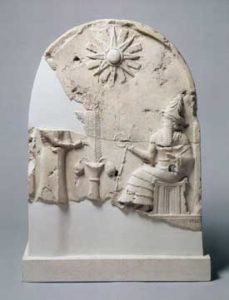The Electronic Text Corpus of Sumerian Literature
(Texts: All Artifacts, Color Coding, & Writings in Bold Type With Italics Inside Parenthesis, are Added by Editor R. Brown, not the Authors, Translators, or Publishers!)
(gods in blue)
The woman Ummu-dhabat,1 the daughter of Nebo-bil-utsur, the wife of Samas-yuballidh,
the son of Bel-Ê-Babara the priest of Samas (Utu / Shamash),2 who has brought a tablet to him,3
and also Samas-edhir, Nidittuv, and Arad-Kin,4 her sons [three in number5],
(and) who has spoken as follows to Bel-yuballidh, the priest of Sippara:6
“They have not (yet) entered the House of the Males; with my sons I have lived;
with my sons I have grown (old) since they were little,7 until they have been counted among the men”;
on the day when Ummu-dhabat [has said this],
may she enter the House of the Males, according to8 the writing of the document
which (is) before Bel-yuballidh the priest of Sippara (Sippar) for Samas-edhir,
 (damaged king stands before Utu, giant alien designated as the Sun god)
(damaged king stands before Utu, giant alien designated as the Sun god)
Nidittuv, [and Arad-Kin]her [three] sons she gives to [the service of the Sun-] god (Utu).
The witnesses are: Nebo-zira-yukin the son of Bel-[natsir] the son of Mukallim,
Bel-natsir the son of Samas-yuballidh; Nebo-[musetiq-udda] the son of Tsillâ;
Rimut the son of Musezib-Bel, the son of Babutu; [… the son] of Bel-yukin, the son of Rimmon-yumê:
(dated) [Sippara1] the 21st day of the month Nisan,
the fifth year of Kambyses, king of Babylon, the king of the world.”
Footnotes
112:1 The name signifies “The mother is good.”
112:2 The Sun-god (Utu), the presiding deity of Sippara (Sippar), where the great temple of E-Babara (Utu’s temple / residence in Sippar), or E-Parra, was dedicated to him.
112:3 Among a literary and business-like people like the Babylonians no act was valid unless embodied in writing, and drawn up according to the legal forms. Consequently a mere verbal declaration, as in the case of Hannah, was not sufficient; it had to be accompanied by the prescribed legal document with the names of the witnesses attached to it.
112:4 “The servant of Kin.” The triad or trinity of deities worshipped at Sippara consisted of Samas (Utu), A (who, in the Semitic period, was regarded as the wife of the Sun-god), and Kin (perhaps the son of Samas and A). The reading of the last name is doubtful, and may be Khur.
112:5 The traces of the characters given by Dr. Strassmaier show that this must be the reading (sal-si anna).
112:6 Sippara, written Sippar in the cuneiform, the Sepharvaim or “two Sipparas” of the Old Testament (2 Kings xvii. 31, etc.), is now represented by the mounds of Abu Habba and Anbar (?). It consisted of two cities, one known as “Sippara of Samas,” and the other as “Sippara of Anunit (Inanna, twin sister to Utu).”
112:7 ’Sikhurrutû.
112:8 We must read akî instead of adî.
113:1 The characters are illegible here, but the fact that Ummu-dhabat appeared before the priest of Sippara shows that we must supply the name of that city.